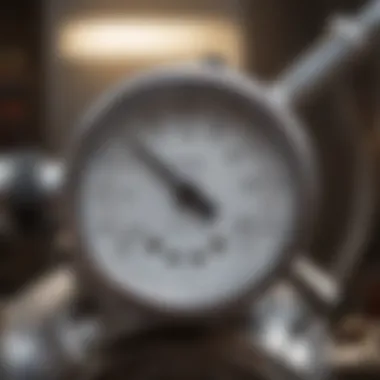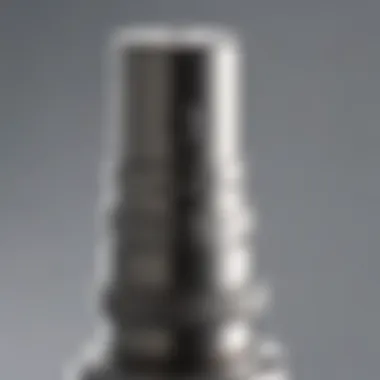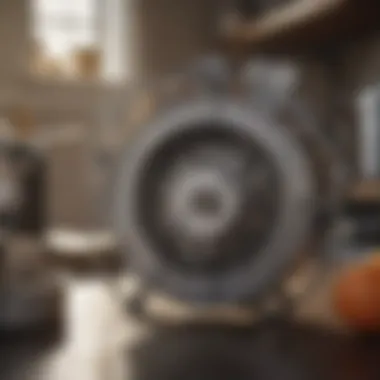Essential Components of Mirro Pressure Canner: A Guide


Intro
Understanding the internal mechanisms of your Mirro pressure canner is crucial for effective home canning. This guide provides a thorough exploration of the various parts that make up the Mirro pressure canner. Knowing how each part functions contributes to better maintenance and optimal performance.
The significance of a good pressure canner cannot be overstated. It ensures proper sealing and preservation of foods, allowing you to create homemade products that can last for years. Knowing the essential parts helps not only in effective operation but also in addressing any issues that may arise during canning.
Overview of Topic
The Mirro pressure canner serves as a vital tool in the home canning process. Primarily designed to cook and preserve food, it uses steam and pressure to maintain ideal conditions for various food items. Understanding this advanced appliance means homeowners can maximize the use of their canner, encouraging a more sustainable, self-sufficient cooking lifestyle.
Importance of the Topic
Canning is becoming increasingly popular among culinary enthusiasts and those who value home food preservation. It allows for creativity in kitchen choices. Familiarity with the parts of the Mirro pressure canner is crucial for both safety and efficient food processing. When canning, all parts of the device must work in unison, ensuring the correct pressure levels are maintained. The guide also emphasizes the need for regular maintenance to keep each component functioning correctly.
A mistake with your canner can lead to spoilage, health risks, and even equipment damage. By understanding each section of the canner, these challenges become more manageable. It ultimately contributes to an enriched canning experience for users.
Common Challenges and Solutions
Common Issues Faced by Homeowners
Many users often experience challenges while operating their Mirro pressure canner. Common issues include:
- Improper sealing of jars, leading to spoilage.
- Inadequate pressure build-up during the canning process.
- Difficulty in cleaning certain parts.
Solutions and Tips to Overcome These Challenges
By implementing specific solutions, homeowners can mitigate these issues effectively:
- Always inspect rubber gaskets and seals for wear and tear. Consider replacing them yearly to ensure a proper seal.
- Regularly check the pressure gauge accuracy to maintain the correct pressure during cooking.
- Use a vinegar solution for cleaning stubborn particles on parts to enhance the longevity of your canner.
Product Recommendations
Investing in quality components for your Mirro pressure canner can dramatically enhance your canning process. Several top market brand products provide excellent options:
- Mirro Gasket: Essential for creating a seal between the canner and the lid. Regular replacement ensures solid closure.
- Mirro Pressure Gauge: Accuracy matters tremendously for safe canning. An annual check-up or replacement is recommended.
- Mirro Dial-Canner or Weighted Gauge sٕpecialties**: Each offers specific benefits for various canning tasks, offering advantages depending on user preference and experience level.
Each of these products contributes to the overall functionality of the canner. Investing in top-quality components leads to better results while ensuring safety.
Step-by-Step Guides
To get the most out of your Mirro pressure canner, consider following these practical steps:
- Preparation: Inspect all parts of the canner thoroughly. Ensure there is no visible wear, especially in the gasket.
- Setup: Add water and place the filled jars inside according to your canner's instructions. Make sure not to overcrowd for uniform pressure.
- Monitor Pressure: Keep an eye on the pressure gauge. It should reach the correct level as per your canning recipe.
- Post-Canning Care: After the cycle is complete, let the canner cool down before opening. Finally, store your jars correctly after cooling.
Each of these steps ensures you are fully aware of how to operate and maintain your Mirro pressure canner, leading to a more effective, safe canning process.
Proper maintenance not only prolongs the lifespan of your canner but also ensures that each canning session is fruitful.
Culmination
Understanding the components and the role they play within the Mirro pressure canner opens doors for successful canning at home. Proper management enhances the user experience while ensuring safety. Both novice and seasoned canners can benefit from this comprehensive round-up of essential parts.
Understanding the Mirro Pressure Canner
The Mirro pressure canner is an essential tool for many households, especially those interested in food preservation. Understanding its functionality is crucial. This section emphasizes aspects like efficiency, safety, and the technical components vital to home canning. Familiarizing oneself with these elements enhances the canning experience and reduces the likelihood of common mistakes.


Overview of Canning
Canning, at its essence, involves sealing food in containers and heating them to kill bacteria, yeast, and molds. This process creates a vacuum seal, extending food shelf-life. Within this topic, safety is paramount. Improper canning can lead to botulism, a rare but potentially fatal illness. Additionally, using pressure canners like Mirro is a safe method for low-acid foods. These include vegetables, meats, and fish. Understanding the types of canning, like water bath and pressure canning, helps individuals decide the best method depending on the food type. Pressure canning is ideal for food preservation since it reaches temperatures above boiling point.
History of Mirro Pressure Canners
The Merro brand holds a significant place in canning history. Established in the early 20th century, it was initially known for the production of aluminum cookware. Over the decades, the shift to pressure canners occurred as demand for durable and safe food preservation solutions increased. The Mirro pressure canner became notable not only for its design but also for its usability.
It has been a trusted ally for homemakers, especially from the 1950s onward. Numerous improvements and innovations have followed the introduction. Notably, advancements in materials ensured greater durability and safety. This includes the introduction of precise pressure gauges and dual functions for canning and cooking. Therefore, understanding this brand's heritage offers context to its reliability in contemporary kitchens. The Mirro pressure canner provides homemakers with the tools needed for efficient food preservation while embodying decades of development aimed at ensuring safety and usability.
Essential Components of the Mirro Pressure Canner
Understanding the essential components of the Mirro pressure canner is crucial for anyone interested in preserving food at home. Each part plays a role in ensuring that the canning process is safe and effective. As a home canner, recognizing these components can save you both time and money. You’ll find that knowing how these parts work together can enhance your overall canning experience.
The Canister Body
The canister body serves as the main vessel of the Mirro pressure canner. It is where the food and jars are placed during the canning process. Typically made of aluminum or stainless steel, the body is constructed to withstand high pressure and heat.
The canister’s capacity varies, enabling users to choose one based on their canning needs. A larger body might be beneficial for those looking to can in bulk, while a more compact size could be suitable for smaller kitchens. It’s important to check for any damages or dents before use, as these could affect performance.
The Lid Assembly
The lid assembly is integral to the operation of the canner. This component locks onto the canister body and seals tightly to create a pressurized environment inside. There are typically latches that help secure the lid, ensuring it does not open accidentally during the canning process.
An important feature of the lid is that it contains a safety valve to release excess pressure. This prevents dangerous situations where too much pressure could build up. It is advisable to inspect the lid regularly for any warping or wear, as a faulty assembly can lead to improper sealing.
Pressure Gauge
Attached to the lid, the pressure gauge is crucial for monitoring internal pressure. Accurate pressure readings are necessary for safe canning, as they dictate how food processes. Many Mirro pressure canners use analog gauges, though digital options are becoming more common.
Regular calibration is essential for precise measurements. If your gauge is inaccurate, you could risk under-processing or over-processing your food. This component deserves careful attention, especially if canning low-acid foods.
Weight Control
Weight control is designed to keep pressure within the canner at safe levels. Generally, it sits atop the lid, allowing steam to escape while preventing it from exceeding the prescribed limits. Instead of a gauge, some might prefer to use weight-control mechanisms, as these can simplify the process.
Weight control units can sometimes get lost or misplaced, so understanding the replacement options is key. When canning, ensuring that this part is functioning properly helps to maintain a consistent temperature throughout the canning cycle.
Gaskets and Seals
Gaskets and seals are components that ensure the lid fits tightly on the canner body. These parts are usually made from rubber or silicone and play a vital role in preventing steam from leaking. Over time, gaskets may wear out and require replacement.
Maintaining proper just correct gasket integrity is necessary to uphold the sealing quality. Regular inspections should be part of your canner maintenance routine. If you notice any signs of cracking or hardening, replace the gasket to guarantee safety and efficiency.
Regularly check the condition of gaskets to avoid any leakage during the use of your canner, which can cause limited pressure and risk unsafe results.
Understanding the essential components of the Mirro pressure canner helps to familiarize users with their tools and maximize their canning efforts efficiently. An informed approach to each part fosters a more secure and satisfactory home canning experience.
Functional Importance of Each Part
Understanding the functional importance of each component of the Mirro pressure canner is crucial for any canner looking to optimize their experience. While canning may seem straightforward, the precise operation of the canner's parts can directly influence the safety and quality of the finished product. Each part has its distinct purpose which addresses specific needs in the canning process. Appreciating these details not only helps in improving the canning outcomes but also informs proper maintenance and timely replacements.
How the Canister Body Works
The canister body serves as the core structure of the Mirro pressure canner. It is designed to withstand high pressure produced during the canning process. The operation of this part is vital. Durable steel materials provide stability, ensuring uniform heat distribution and even cooking of the jars inside. This consistency is important for food safety.
Should the body experience damage, it can lead to pressure leaks which directly affect the canning efficiency. Rust can also accumulate over time. A clean and inspected canister promotes a safe environment for food preservation. Regular checks help detect wear and tear before they become problematic.


Lid Assembly and Its Role
The lid assembly encapsulates the pressure canner by providing a tight seal essential for successful canning. It partially controls the internal temperature and pressure settings. A well-fitting lid prevents steam escape. This tight seal is crucial, as escaping steam can hinder the air removal from jars, possibly resulting in food spoilage.
Furthermore, the lid is equipped with safety features such as pressure release valves. These elements are important to monitor and prevent dangerous pressure buildup within the canner. Regular cleaning and checks for distortions are necessary to maintain effectiveness.
Understanding Pressure Measurement
Pressure measurement is a key aspect of safe canning. The pressure gauge provides crucial feedback about internal conditions, detecting variations that can signal whether the canner is functioning optimally. Understanding this measurement ensures that the heat applied is sufficient to kill harmful bacteria.
Both dial and weighted gauges have their specific methods of monitoring. Familiarity with their operation can greatly improve canning quality. That said, regular calibration is essential to ensure accuracy over time.
Weight Control Mechanism
The weight control mechanism is how the pressure canner adjusts to produce the desired pressure. The weight should fit correctly on the steam vent, allowing for consistent pressure during the heating process. Different weights can yield distinct pressure levels, hence making awareness of the required level significant in relation to the recipe being preserved.
One consideration to note is that the weight must be cleaned regularly to prevent blockages. This routine prevents malfunctions during operation, preserving the intended pressure consistency.
Importance of Gasket Maintenance
The gasket affixed along the inside of the lid acts as a seal, ensuring that the canner maintains the required pressure. It prevents steam escape during the heating process. Without proper maintenance, gaskets can subsequently degrade and become less effective, leading to problems with pressure retention.
Inspection is necessary, ideally before every use. Look for signs of wear, such as cracking or deformation. Broken gaskets may compromise safety as well as recipe success. If care is taken, purchasing a replacement is straightforward and provides significant peace of mind during use.
Common Issues with Mirro Pressure Canners
Understanding common issues with Mirro pressure canners is essential for maintaining their functionality and ensuring success during the canning process. Awareness of these challenges helps both novice and experienced canners diagnose problems early. Additionally, knowing how to address these problems enhances the lifespan of the canner and ensures safe food preservation.
Pressure Loss Problems
Pressure loss in a Mirro pressure canner can result in under-processing of foods. This situation can lead to spoilage and potentially dangerous bacteria growth.
Common causes of pressure loss include:
- Worn gaskets: Gaskets are integral to maintaining a seal. If they become old or damaged, they cannot hold pressure effectively.
- Improperly fitted lids: If the lid is not securely locked in place, pressure may escape during the canning process.
- Clogged vent pipes: Obstructions can prevent proper pressure build-up.
To prevent pressure loss, inspect the gaskets regularly. Replace them as needed. Properly locking the lid before starting also helps avoid this issue. If using a new canner, ensure vent pipes are clear before each use.
Difficulty Achieving Seal
A proper seal is crucial for food preservation. However, many users encounter problems achieving a secure seal in their canners. Typical reasons for seal failure include:
- Dirty sealing surfaces: Residues on the lid or jar can prevent a complete seal.
- Incorrect jar placement: Jars should be seated evenly within the canner. Misalignment can lead to sealing failure.
- Old or damaged gaskets: If the gasket has signs of wear, it might not create a perfect seal.
Cleaning the sealing surfaces before use can enhance sealing success. Furthermore, inspecting gaskets prior to canning allows for an assessment of their condition. It’s wise to replace any that show wear and tear.
Calibration of Pressure Gauge
A pressure gauge displays crucial information about the internal pressure of the canner. Calibration is vital because inaccurate readings can lead to unprocessed or unsafe food outcomes.
Several issues relate to gauge calibration:
- Improper initial setup: If the gauge is not calibrated before use, it may display inaccurate pressure levels.
- Damaged or malfunctioning gauges: A broken gauge can mislead users, risking food safety.
- Environmental reliance: Humidity and temperature fluctuations might affect gauge performance.
Regularly testing the gauge for accuracy is recommended. Using a pressure gauge tester can provide a checklist for ensuring proper readings. If a gauge is found to be off, replacing or recalibrating it is critical to avoid future canning hazards.


Proper maintenance and regular checks can significantly increase the success and safety of your canning experience.
Replacement Parts and Maintenance
Replacement parts and maintenance represent a significant aspect of owning and operating a Mirro pressure canner. Understanding these elements makes a meaningful difference in performance, safety, and longevity. Canners are an investment, and diligent care ensures their functionality over many canning seasons. Knowing when and how to replace parts becomes integral to mastering home canning.
Identifying When to Replace Parts
It is crucial to recognize signs that a part may need replacement. Regular inspections can prevent larger issues that may impede safe canning.
- Gaskets and Seals: Check for cracks, hardening, or loss of elasticity. A compromised gasket may lead to pressure loss.
- Pressure Gauges: If the pressure gauge becomes difficult to read or displays inconsistent readings, it should be tested and replaced if necessary.
- Weight Control: Ensure that the weight control is neither warped nor damaged. Misalignment can hinder effective pressure regulation.
It is also useful to refer to the user manual for guidelines on wear attributes or replacement intervals specific to your model. Keeping chronicled notes of all maintenance helps develop an intuition for your canner's needs.
Where to Source Replacement Parts
Knowing where to source quality replacement parts enhances the canning experience. A successful canning session begins with having tools optimized for performance.
- Manufacturer Resources: Check direct offerings from the Mirro company. Their website often provides genuine parts recommended for compatibility.
- Local Appliance Stores: Many local retailers handle components for canners and other preservation equipment. Speaking to the staff can often uncover valuable insights.
- Online Shopping Platforms: Websites like Amazon, eBay, or specialized culinary equipment stores offer a wide selection of parts. Customer reviews on these platforms may help assess quality.
Always verify seller credibility and the suitability of any parts for your specific canner model before purchasing. Ensuring compatibility mitigates the risk associated with improper fittings.
Proper Maintenance Techniques
Adopting good maintenance techniques preserves the integrity of the Mirro pressure canner. Regular and detailed maintenance ensures long-term functionality and safety. Here are essential practices to keep in mind:
- Regular Cleaning: After each use, clean the canner's body and lid to prevent build-up from residue or food. Avoid abrasive cleaners, which can damage surfaces.
- Gasket Care: Rinse gaskets in warm water and dry them before reassembling. lonf-lasting strength is vital for maintaining optimal pressure levels.
- Storage Considerations: Store the canner in a dry location. Extreme Foos temperature changes or water exposure can prompt wear to seals and parts.
- Periodic Checks: Schedule routine inspections every few months to assess overall condition. Take note of accumulated wear as an indication for replacement.
Implementing these methods can prolong the life of the canner and ensure safe operation for many canning seasons.
Best Practices for Safe Canning
Canning is a meticulous process that demands attention to safety and technique. This section highlights the best practices for safe canning, guiding users to ensure both quality and safety in their preserved goods. Whether you are a novice or an experienced canner, understanding the necessary precautions can significantly enhance your canning experience. Ensuring the integrity of your food while maintaining health considers various aspects starting from equipment to operational methods.
Safety Precautions
Every canner should recognize the paramount importance of safety precautions. This matter is not just about following guidelines but about protecting yourself and your loved ones from foodborne illnesses. The following are vital safety considerations you must respect:
- Use Valid Recipes: Always follow updated and researched recipes. Obtain canning guidelines from trusted resources such as the USDA or established cooking websites. Bassically, stick to well-established preservation procedures.
- Check Equipment: Ensure that your Mirro pressure canner functions correctly. Look for visible damage, unsealed gaskets, or worn weights.
- Monitor Pressure Levels: The correct pressure is essential to effectively canning. Using a pressure gauge allows precise adjustments according to altitude and recipe requirements.
- Sterilize Jars Properly: Prior to canning, jars should be sterilized. Boil them for at least ten minutes. This step is crucial to eliminate harmful bacteria that might lead to spoilage.
- Label Canned Goods: Mark your jars with the date and contents to keep track of freshness. Rotation of your inventory can help prioritize using older goods first.
A systematic approach towards these precautions not only guarantees safety but also preserves the rich flavors of your processed foods may enhance their shelf life significantly.
"Safety cannot be compromised when it comes to food preservation. Adhering to best practices secures not only the food but also the health ofthose who consume it."
Testing Equipment Regularly
Regular testing of canning equipment is essential for proper functioning and overall safety. Despite performing routine checks, all canning equipment can experience wear over time. Testing is pragmatic for the following aspects:
- Gauge Accuracy: A faulty pressure gauge can lead to either under-processing or over-processing of jars. Run a repeatability check against a national institute-approved instrument at least once a year.
- Sealing Effectiveness: Check lids for seals to prevent spoilage or contamination. This involves an inspection of the can settings after applying the pressure. The time required may vary by recipe and jar size.
- Gasket Integrity: Look for signs of wear or brittleness. Replace gaskets periodically in order to maintain an airtight seal, which is vital for safe food storage. There's no need to make guesses; replace if there are any uncertainties instead.
- Overheat and Damage Risks: Keep a sharp eye on debris build-up. Debris on burner and around lid fittings can affect performance while risking injury in use. Quick maintenance inspections can resolve potential hazards before they escalate.
Epilogue
The conclusion of this article serves as a vital element that distills the crucial topics discussed about the Mirro pressure canner. Here, we can summarize how every part contributes to the overall efficacy and versatility of this canning device. Understanding each component not only enhances users' knowledge but also promotes confidence in operating the canner effectively.
One of the key benefits of intimate familiarity with the pressure canner’s parts is safety. Knowing the functionality of the lid assembly, the operational role of the pressure gauge, and the importance of gaskets ensures proper food preservation while reducing the risk of accidents. This familiarity is especially important for those new to canning, demystifying the process and making it less intimidating.
Additionally, the information provided empowers housewives and homeowners to assess and perform their own maintenance. By recognizing when to replace mechanism parts or how to calibrate the equipment, they can avoid purchasing replacements hastily. This proactive approach not only saves money but also extends the lifespan of the canner.
The craft of canning goes beyond just preservation; it is an art and science that can deliver wholesome meals throughout the year. Each weight control adjustment or assessment of pressure allows canners to achieve a sense of accomplishment, serving as an avenue for creative expression.
Familiarizing oneself with the components and usage of the Mirro pressure canner cultivates not only knowledge but ownership over the canning process. It increases one’s self-reliance and opens new culinary doors while ensuring safety and proper maintenance practices for continued enjoyment and efficacy.
So consider this guide as not just a resource but a companion on the journey through the fascinating world of home canning, fortifying both household practices and delicious home-cooked results.







